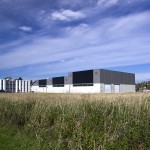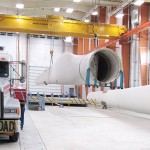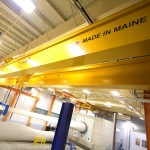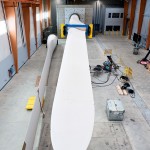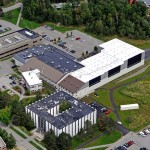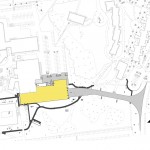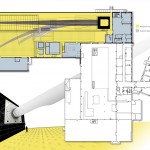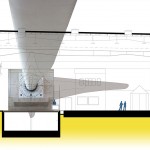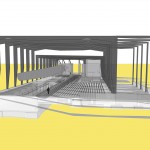Advanced Structures and Composites Center: Offshore Wind Laboratory
Project Name: Advanced Structures and Composites Center: Offshore Wind Laboratory
Creative design solutions at the University of Maine’s Offshore Wind Laboratory were born from the facility’s “super-sized” mission – to create a space capable of testing wind turbine blades taller than a 21-story building.
One of the design team’s first decisions was where to place this 37,000 SF addition to UMaine’s Advanced Structures and Composites Center. Located in the heart of the Orono campus, the addition needed to allow trucks the turning radius required to deliver 230-foot-long blades. An east-west orientation allowed a 3,400 SF transpired solar wall that preheats the building’s air during Maine’s cold winters and preserved adjacent green areas and wetlands.
The project team was charged with designing a cost-effective, energy-efficient building that harmonized with the center’s existing lab and office facility. The resulting tiered roof design allowed the height needed to accommodate the oscillation of the gigantic blades at the one end of the lab, while lower ceilings in the center and opposite end reduced both structural costs and future heating bills.
It was critical to the client that the lab’s lighting be consistent to mitigate shadows. Translucent skylights and windows, combined with automatic lighting controls, helping keep illumination steady throughout the day. The lab’s first floor control room features large windows and a raised floor to provide unobstructed visual access. A second floor conference room allows onlookers to view testing efforts below.
The WBRC design team also customized the floor space to ensure safety, accuracy and efficiency of testing. A covered floor trench housing power, communication, and hydraulic lines runs the length of the test bay, allowing R&D staff to plug in monitors and equipment where needed.
In addition to providing the structural testing floor, the laboratory also offers a salt-water immersion tank and a nanostructures lab. Fiberglass materials were chosen by the designer to combat corrosion in the salt-water testing area, and the nanostructure lab was isolated from the adjacent high bay lab using compressible filler, protecting its equipment from the vibrations created by blade testing.
The Offshore Wind Lab’s mission is centered around sustainability, and its LEED Gold certification was achieved in innovative ways, including reclaiming the heat generated by the lab’s hydraulic pumps. The massive wind blade test stand was constructed using 40% fly ash, and over 95% of construction waste was recycled.

